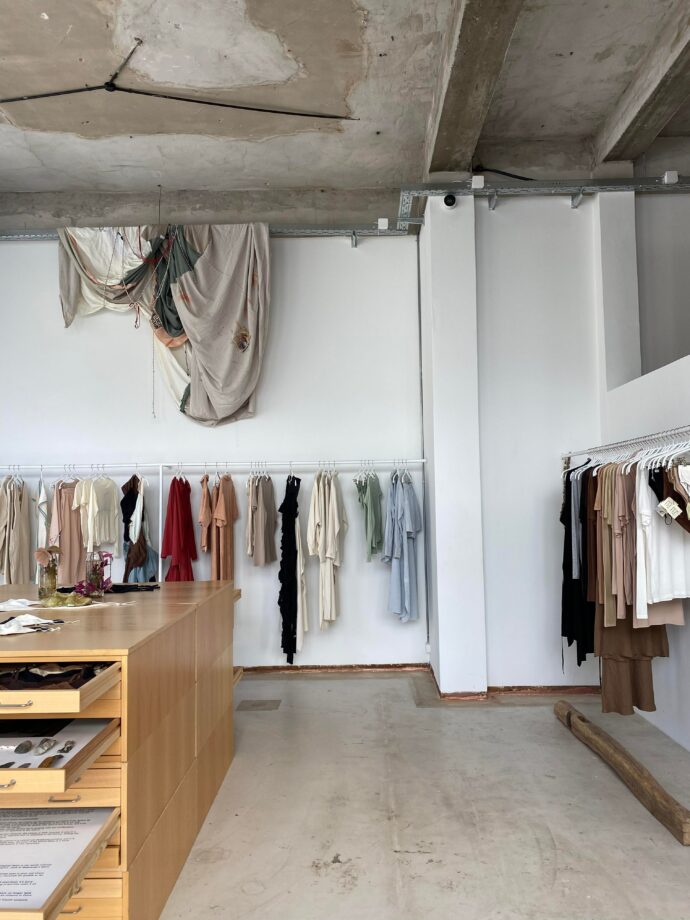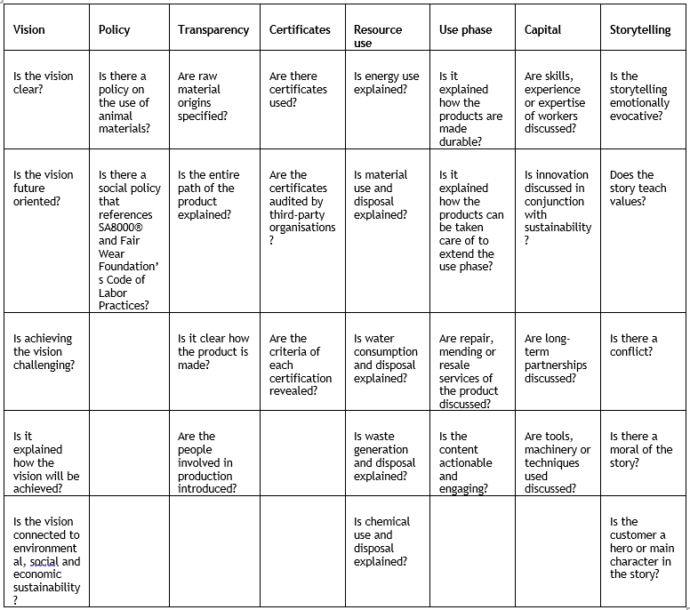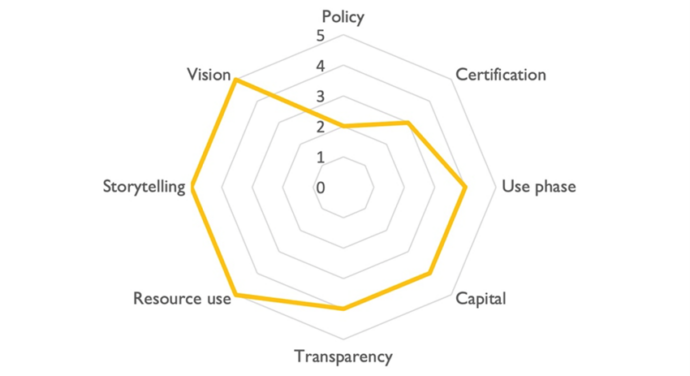The article deals with the issue of communicating sustainability in the fashion industry. The problem with many small sustainability-focused fashion brands today is that they are not communicating their sustainability efforts effectively enough for the customers to see that sustainability is an inherent quality of small brands. Customers are not correctly identifying the most sustainable brands. This may be because the term “sustainability” is vague and unclear and sustainability initiatives are difficult for customers to understand (Allen 2016, 15).
 Photo Jennie Barck
Photo Jennie Barck
The small fashion brands are struggling to get the message out regarding what exactly it is that makes them sustainable. Smaller brands are not able to communicate sustainability as thoroughly as larger brands and it may even come across as them hiding information (Brydges et al. 2022, 363). It is difficult therefore for them to differentiate themselves from those brands that seek to confuse customers with false claims of sustainability and greenwashing. The question that this study answers is: How can a small slow fashion brand communicate sustainability clearly and effectively and avoid greenwashing?
Companies nowadays have more opportunities than ever to communicate their sustainable practices to customers, but information about these initiatives is still lacking (Da Giau et al. 2016, 77). For instance, they can do it through ratings by independent third parties. Being listed at the top of sustainability ranking systems gives customers the perception that the brand is trustworthy in its claims of sustainability. There are many rating websites, but one sustainability rating system suitable for small fashion brands is Good On You. However, many small brands are struggling with reaching the highest scores in fashion brand ranking. Many do not have the time, financial or human resources to invest in carbon calculations, performing LCAs (Life Cycle Assessment), transparency software, certifications, third-party auditing, writing policies or sustainability reporting to strengthen their claims of sustainability.
Creating a sustainability communication model for small fashion brands
The article offers an easy-to-use model that small fashion brands can use to develop communication strategies to help them achieve high ratings through clear and effective communication. To put together a sustainable communication model fit for small fashion brands, the study used elements from different existing models – the Good On You ranking system, the Operational Model for Evaluating Corporate Websites (Siano et al. 2016) and the Shades of Green instrument (Turunen & Halme 2021). The sustainability communication model highlights eight methods of communication and the items that each method includes. Each method of communication has between two to five items that should be checked off for holistic, effective, and credible sustainability communication.
 Figure 1: A sustainability communication model from small fashion brands (Barck 2023).
Figure 1: A sustainability communication model from small fashion brands (Barck 2023).
Vision should state the explicit connection to three domains of sustainability called “triple bottom line” – social, environmental, and economic (Elkington & Rowlands 1999). It should also be explained how the vision can be and is implemented in practice.
Policy relates to social sustainability, as it should cover the practices of the company in protecting worker’s rights. The SA8000® guidance and the Fair Wear Foundation’s Code of Labor Practices are the policies to follow. The brand should additionally have policies about the use of animal products and list which ones they are not using.
Transparency relates to both social and environmental sustainability. It shows the distances throughout the supply chain, signifying CO2 emissions. Knowing the origin of products allows customers to gain a better understanding of the production process and the people involved and this can drive behavioural change in consumption habits. This category favours tracking and communicating the lifecycle of the product from start to end of life. It allows customers to see concrete evidence of the practices of the company.
Certification also relates to social and environmental sustainability, as they often certify working conditions and the controlled use of chemicals and water management. The more certifications used, the better. It gives important third-party assurance and credibility to the claims made by the company. Most small fashion brands use GOTS, GRS and OCS certificates.
Resource use applies to material, energy, water, waste and chemical use and disposal. This belongs to the environmental sphere as it relates to emissions and the effect of production on the environment in general. It is also a way of showing concrete action taken to combat environmental sustainability issues, beyond just certifications.
Capital encompasses financial, human, social and physical capital and is connected to economic sustainability. It covers the skills and experience of workers, the sustainability innovation of the company, long-term partnerships between factories and brands, profit sharing and machinery owned and used in production. As economic sustainability is not touched on explicitly by the other categories, it was found to be crucial to make explicit references to it in this model. It is called “capital” here as it highlights the resources the brand has for it to be economically sustainable. This also emphasises the holistic and eco-system thinking necessary for sustainability.
The use phase relates mostly to environmental sustainability. This is about enhancing the durability of the product with the right design, material, and manufacturing choices, as well as communicating about services to lengthen the use phase of the product even further. This might include repairing and mending services and products as well as a resale platform. The use phase is important because it is the only one of the categories that activates the customer to participate, which is found to be important in sustainability communication.
Lastly, we have storytelling, which is key in effective communication as it is the only one that focuses on aiming to evoke emotion in the reader. It is effective in making the customer remember the story of the brand and learning something new. Storytelling can be done in relation to all aspects of the triple bottom line.
Applying the scale from 0 (min) to 2 or 5 (max), depending on the method of communication, a small fashion brand can evaluate its communication. The model is not designed to be used as a scoreboard, but rather as a guide to reference when building a communication strategy. It can nudge brands in the direction of emphasising certain items in their communication that are currently missing.
 Figure 2: The sustainability communication model for small fashion brands (Barck 2023)
Figure 2: The sustainability communication model for small fashion brands (Barck 2023)
The model can be used as a way for brands to rate highly on Good On You, but also to make sure their communication is done clearly and in a way that the customers will believe in its credibility. It can also be used as a checklist to ensure that the organisation is avoiding greenwashing and communicating sustainability holistically, as the model offers clear and comparable sustainability actions. Brands can also choose to use the model as a guide of the best practices, from which they can choose which aspects fit their communication strategies. Therefore, the model has many ways of using it. It is especially relevant to small brands in fashion, but it could be used by organisations in other B2C industries as well.
The article is based on Jennie Barck’s thesis project, the full text of which can be found here. It is written on the topic of Laurea’s Service Business and Circular Economy Research Program, aimed at studying, analysing, and co-creating business ecosystems and service innovations that foster sustainable development. The program hosts two new projects in sustainable fashion in which Olga Gurova is involved. One of them, The Village of Sustainable Clothing (VISU), aims to explore the potential of collaboration between fashion and textile industry companies, educators, and young adults to achieve more sustainable clothing consumption. Another one, Enhancing the behavioural and business change of the second-hand textile industry in the Central Baltic region (BALTIC2HAND), deals with the problem of underused textiles. Its goal is to improve the business models of second-hand companies and other companies that want to add a second-hand operation to their business and to enhance consumers’ use of the second-hand market as both sellers and consumers.
References:
- Allen, M. 2016. Strategic communication for sustainable organizations: Theory and practice. Cham: Springer.
- Barck, J. 2023. Communicating sustainability clearly and effectively to avoid greenwashing: Small slow fashion brands. Master of Business Administration Thesis. Laurea University of Applied Sciences.
- Brydges, T., Henninger, C.E. & Hanlon, M. 2022. Selling sustainability: investigating how Swedish fashion brands communicate sustainability to consumers. Sustainability: Science, Practice and Policy, 18(1), 357-370.
- Da Giau, A., Macchion, L., Caniato, F., Caridi, M., Danese, P. Rinaldi, R. & Vinelli, A. 2016. Sustainability practices and web-based communication: an analysis of the Italian fashion industry. Journal of Fashion Marketing and Management, 20(1), 72-88.
- Elkington, J. & Rowlands, I.H. 1999. Cannibals with forks: The triple bottom line of 21st century business. Alternatives Journal, 25(4), 42.
- Evans, S. & Peirson-Smith, A. 2018. The sustainability word challenge: Exploring consumer interpretations of frequently used words to promote sustainable fashion brand behaviors and imagery. Journal of Fashion Marketing and Management: An International Journal, 22(2), 252-269.
- Henninger, C.E., Alevizou, P.J. & Oates, C.J. 2017. IMC, social media and UK fashion micro-organisations. European Journal of Marketing. 51(3), 668-691.
- Siano, A., Conte, F., Amabile, S., Vollero, A. & Piciocchi, P. 2016. Communicating sustainability: An operational model for evaluating corporate websites. Sustainability, 8(9), 950.
- Turunen, L.L.M. & Halme, M. 2021. Communicating actionable sustainability information to consumers: The Shades of Green instrument for fashion. Journal of Cleaner Production, 297, 126605.